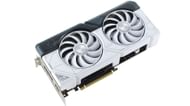Many games require more than 8GB VRAM and run terribly when played on such GPUs. Titles such as Last of Us: Part 1, Forspoken, Plague Tale Requiem, Final Fantasy XIV, Indiana Jones and the Great Circle, and others are prime examples of this issue. These games either experience significant FPS drops or crash outright when played with High/Ultra Texture settings on a graphics card with 8GB memory.
High-res textures provide games with ultra-realistic environments, and they don't decrease any performance, so long as your GPU has enough VRAM. Both AMD and Nvidia refused to provide more than 8GB of memory for their low-end and mid-range graphics cards, such as the RTX 4060, 4060 Ti, and Radeon RX 7600. This makes it impossible for budget gamers to enjoy quality textures in their favorite titles.
Current leaks indicate that the upcoming GPUs like RTX 5060 and 5060 Ti will still retain 8GB of memory. This begs the question, should gamers buy these graphics cards in 2025?
In this article, we share an in-depth analysis and explanation as to whether you should consider buying a graphics card with 8GB VRAM.
Note: Some aspects of this article are subjective and solely reflect the writer's opinions.
What is the adequate memory capacity for GPUs?

The amount of memory a GPU should have depends on the type of resolution it targets in a game at High/Ultra graphics settings. Here's a list to better describe them:
- For 4K resolution, a graphics card should have 20GB memory or higher.
- For 2K resolution, a GPU should have 16GB memory or higher.
- For 1080p resolution, a graphics card should have 12GB memory or higher.
This is why the RTX 4060 GPU, which has 8GB of memory, is not really suitable for 1080p gaming, even though Nvidia describes it as such. The same is also true for the RTX 4060 Ti 8GB model and Radeon RX 7600. None of these cards are ideal graphics cards for gaming at 1080p.
What sort of games are playable on a graphics card with 8GB memory?
Most competitive games, such as Counter-Strike 2, Rainbow Six Seige, Apex Legends, and others, can be played on a GPU with 8GB memory. However, a few competitive titles like COD: Warzone have started using 8GB VRAM at higher settings on a graphics card that has more memory.
Even Fortnite has started using more memory when played at higher settings like Lumen. Even other competitive titles may require more memory in the future, so buying an 8GB GPU makes little sense in 2025, especially when there are options like Intel Arc B580, which has 12GB VRAM and costs less than other popular 1080p graphics cards.
Which games are unplayable on a GPU with 8GB memory?

Many newer AAA titles, like Last of Us: Part 1, Forspoken, Hogwarts Legacy, Halo Infinite, Plague Tale Requiem, Final Fantasy 14, the new Indiana Jones and the Great Circle, and others, require more than 8GB memory. If they are played on a GPU with 8GB memory, they either run terribly, crash, or display graphical glitches that look quite bad.
This will only get worse when more games with photorealistic graphics launch in the future, which is bound to happen. Those games are sure to have high-res textures that don't run well on graphics cards with 8GB VRAM.
Should you consider getting a GPU with 8GB memory in 2025?
As you now know, the situation is quite bad, especially with AAA games that require memory. One could argue that keeping the settings at Medium with lower textures should fix the performance issues from VRAM overspilling, but that's not an ideal solution.
When you are paying $250 or $300 for a graphics card, do you really want to play games at Low/ Medium settings? Not to mention, even a few competitive games have started using more than 8GB of memory. Therefore, we cannot, in good conscience, recommend a GPU with 8GB memory to users in 2025.
Also read: Everything we know about the new Intel Arc B570 and B580
